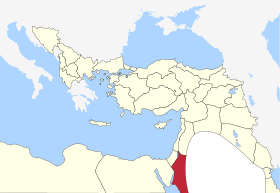- Hejaz Vilayet
-
Hicaz Vilayeti
ولاية الحجاز
Vilayet of the HejazVilayet of Ottoman Empire ← 
1845–1916  →
→Hejaz Vilayet in 1900 Capital Mecca[1] History - Established 1845 - Disestablished 1916 Population - 1914[1] 300,000 Today part of  Saudi Arabia
Saudi ArabiaThe Vilayet of the Hejaz refers to the Hejaz region of Arabia when it was under the Ottoman Empire. Hejaz was governed by the Eyalet of Egypt for most of its existence, but it later became a separate province (vilayet). At the beginning of the 20th century it reportedly had an area of 96,500 square miles (250,000 km2).[2]
The population for the vilayet is given by the 1885 Ottoman census as 3,500,000,[2] an unreasonably high number for this barren land of deserts which would have been twice the whole population of the far more fertile Ottoman Mesopotamia.
Despite its lack of natural resources, the region had great political importance as the cradle of Islam and was a source of legitimacy for the Ottomans' rule.[3] Bedouin tribes dominated the region, and Ottoman control over them was mostly indirect, appointing governors to Medina and Jeddah but allowing local rule elsewhere. Only those two towns had permanent garrisons.[3]
Subsidies provided by the state and zakat were the main source of income for the population of the two holy cities, but trade generated by the hajj was also an important source of revenue.[3]
Contents
History
The Hejaz region was formerly under the Mamluk Sultanate until its defeat and take over by the Ottoman Empire in 1517.[4] After its annexation, it was administered by the Sharif of Mecca, which represented imperial authority in the region.[5]
In the early 19th century Wahhabi Muslims, a puritanical sect from the Najd region, began to raid the holy cities and oases of Hejaz.[5] The Ottoman government found itself unable to confront the Wahabis, and gave the task of defeating them to the powerful Muhammad Ali Pasha of Egypt.[6] The war that followed ended only in September 1818, with the defeat and dissolution of what was known as the First Saudi State. From 1818 to 1845, the region would be administered by Egypt, until Muhammad Ali was forced to restore Hejaz to the Sultan as a result of the Second Turko-Egyptian War.[6]
The Ottomans completed the Hejaz Railway, linking Damascus to Medina, in 1908, but the railway was severely damaged during World War I and later abandoned.[7] In 1916, as a result of the McMahon–Hussein Correspondence, Sharif Hussein ibn Ali declared himself King of the Hejaz.
Administrative divisions
Sanjaks of the Vilayet:[8]
- Sanjak of Mekke-i-Mükerreme
- Sanjak of Medine-i-Münevvere
- Sanjak of Cidde
See also
- Sharifate of Mecca
- Anglo-Ottoman Convention of 1913
References
- ^ a b Encyclopedia Small Silver Coins at Google Books By Roger Dewardt Lane
- ^ a b Asia by A. H. Keane, page 459
- ^ a b c Encyclopedia of the Ottoman Empire at Google Books By Gábor Ágoston, Bruce Alan Masters
- ^ Hejaz (region, Saudi Arabia) -- Britannica Online Encyclopedia
- ^ a b Encyclopedia of the Stateless Nations: D-K at Google Books By James Minahan
- ^ a b Muddle of the Middle East, Volume 2 at Google Books By Nikshoy C. Chatterji
- ^ Nabataea: Hijaz Railway: History
- ^ Ceziretül Arab – Hicaz ve Yemen Vilayetleri | Tarih ve Medeniyet
External links
 Chisholm, Hugh, ed (1911). "Hejaz". Encyclopædia Britannica (11th ed.). Cambridge University Press. http://www.1911encyclopedia.org/Hejaz.
Chisholm, Hugh, ed (1911). "Hejaz". Encyclopædia Britannica (11th ed.). Cambridge University Press. http://www.1911encyclopedia.org/Hejaz.
 Subdivisions of the Ottoman Empire
Subdivisions of the Ottoman EmpireEyalets (1363–1864) AfricaAnatoliaAdana · Aidin · Anatolia · Ankara · Archipelago · Diyarbekir · Dulkadir · Erzurum · Hüdavendigâr · Karaman · Karasi · Kars · Kastamonu · Rum · Trebizond · VanAsiaEuropeVilayets (1864–1922) AnatoliaAdana · Aidin · Ankara · Archipelago · Bitlis · Diyâr-ı Bekr · Erzurum · Hüdavendigâr · Istanbul · Kastamonu · Konya · Mamuret-ul-Aziz · Sivas · Trebizond · VanEuropeElsewhereVassals and autonomies Cossack Hetmanate · Cretan State · Crimean Khanate · Khedivate of Egypt · Principality of Moldavia · Sharifate of Mecca · Republic of Ragusa · Eastern Rumelia · Principality of Samos · Serbian Despotate · Duchy of Syrmia · Principality of Transylvania · Tunis Eyalet · Principality of WallachiaSee also the list of short-lived Ottoman provinces Categories:- States and territories established in 1845
- States and territories disestablished in 1916
- Vilayets of the Ottoman Empire in Asia
- Ottoman Saudi Arabia
Wikimedia Foundation. 2010.


